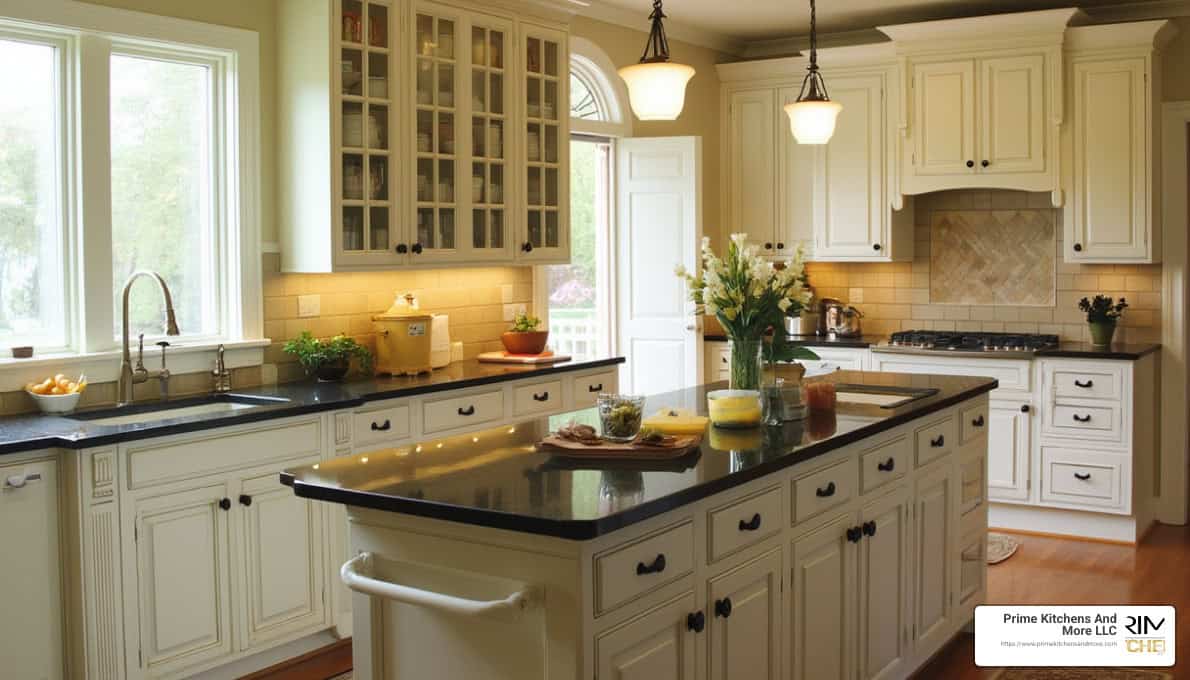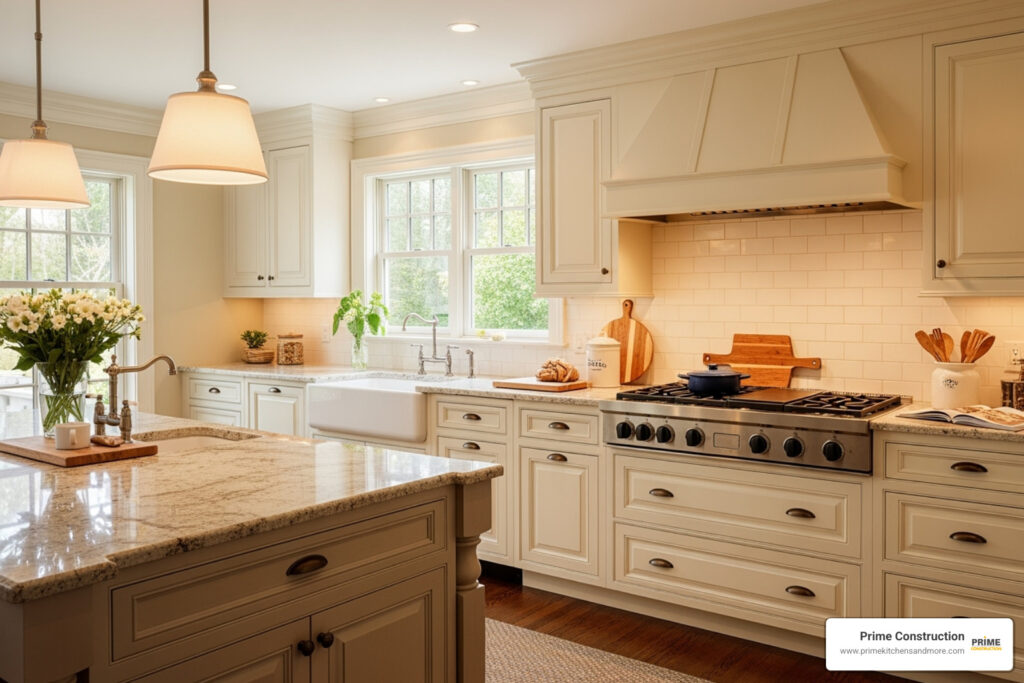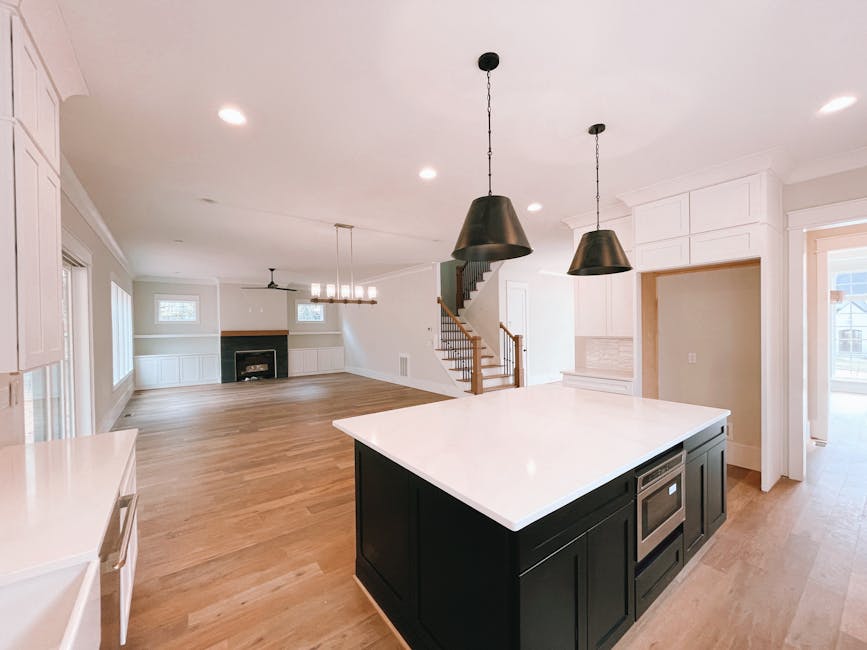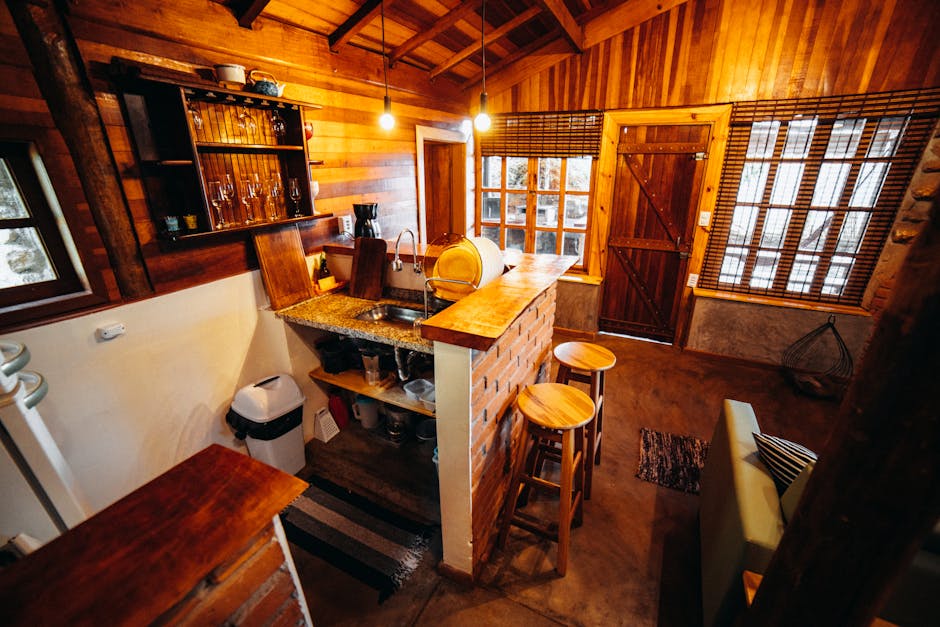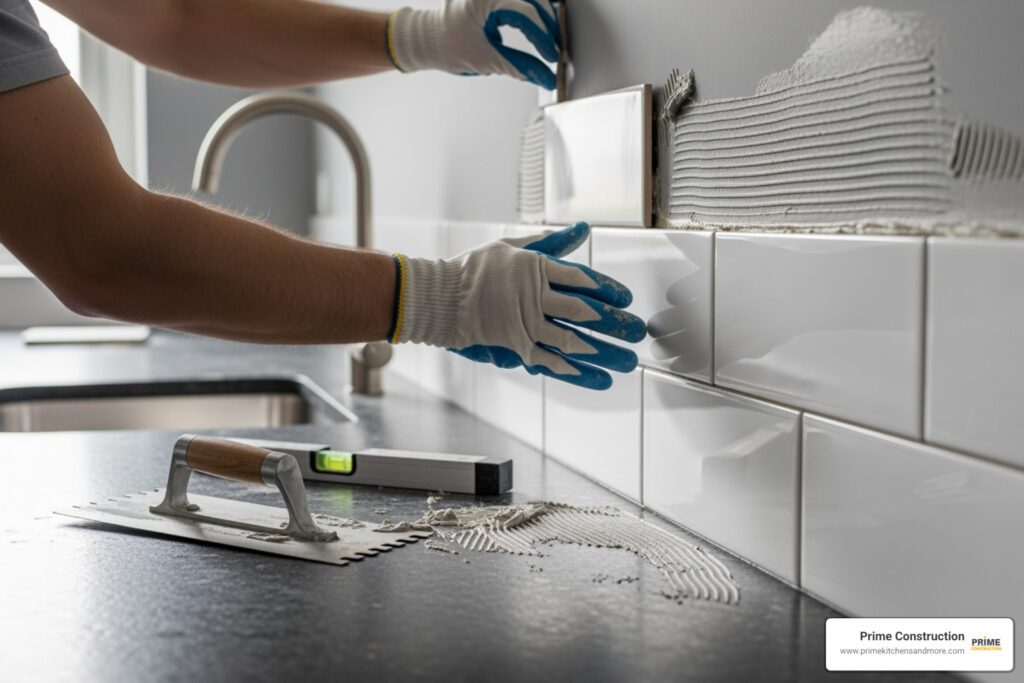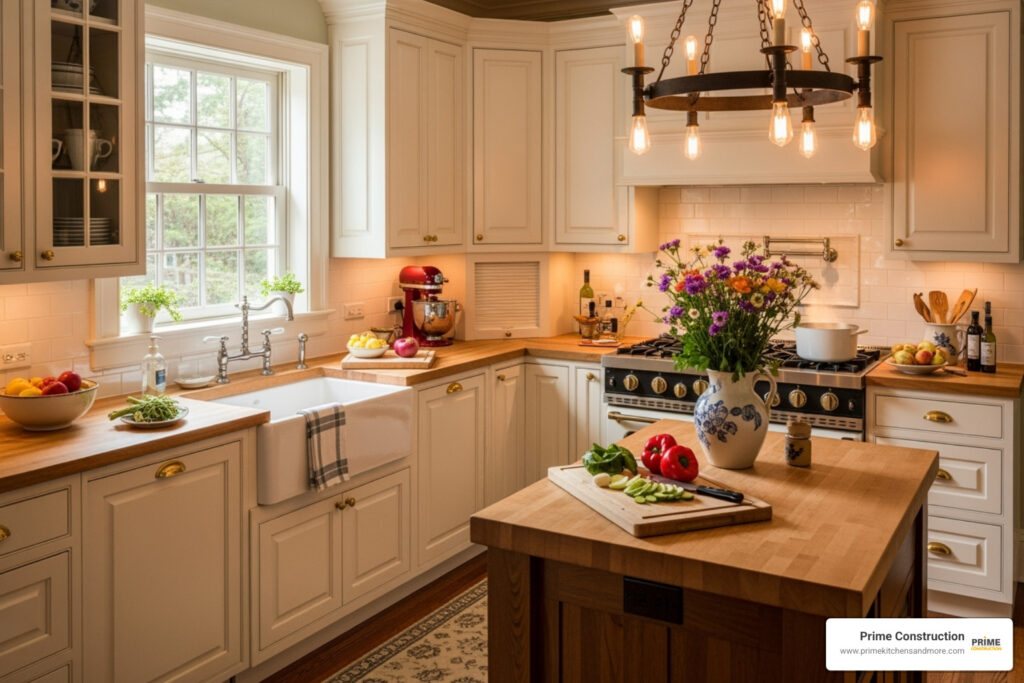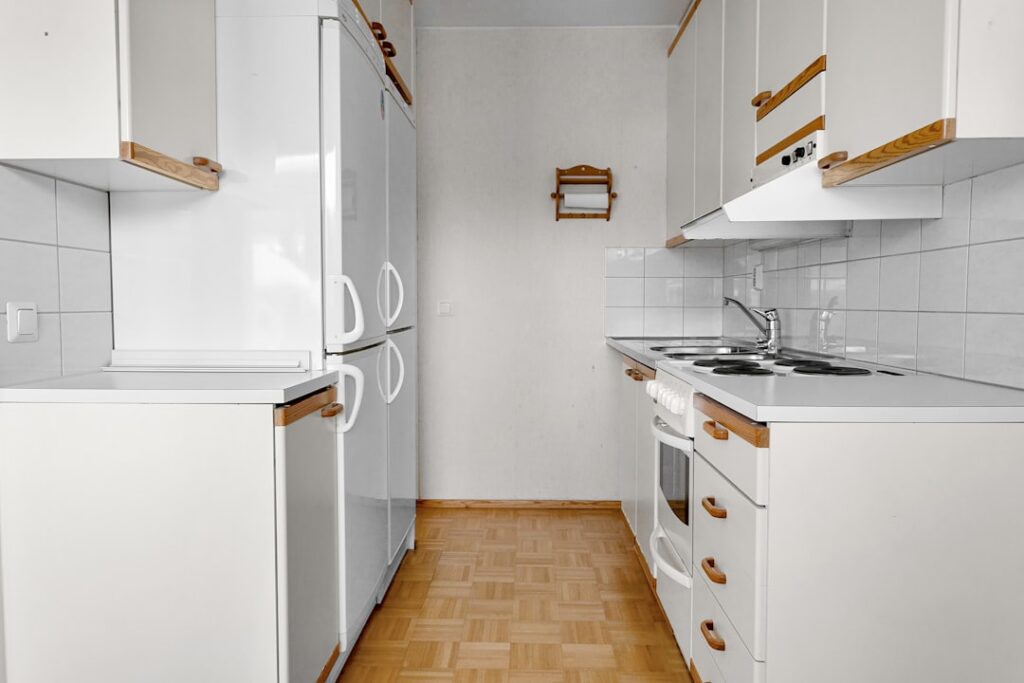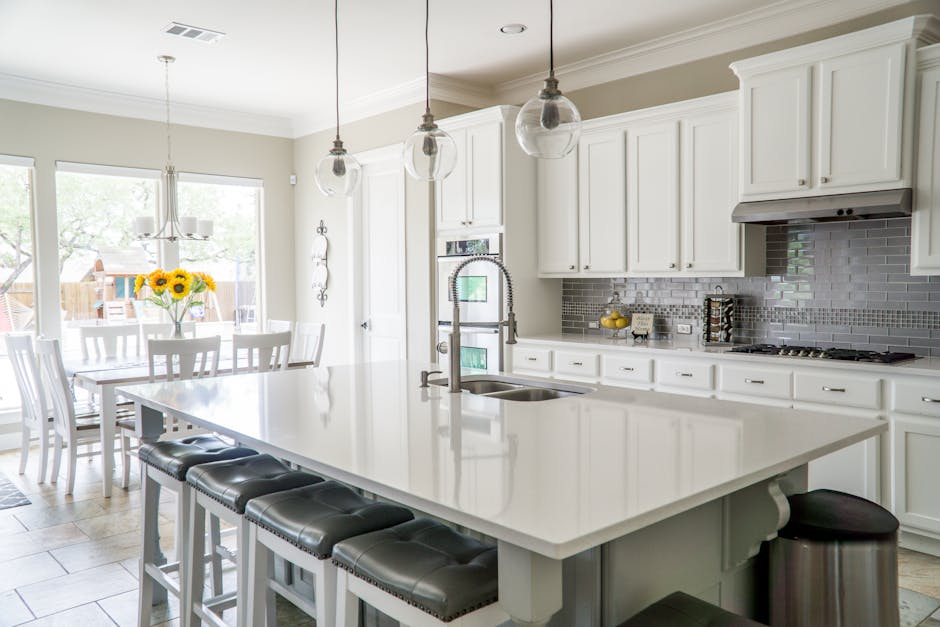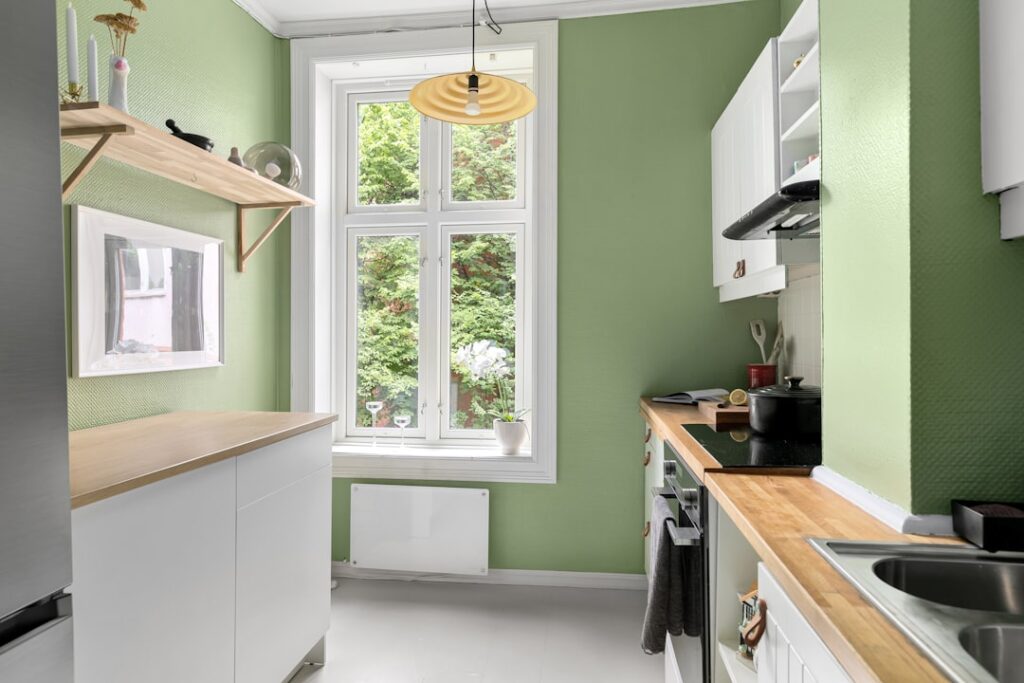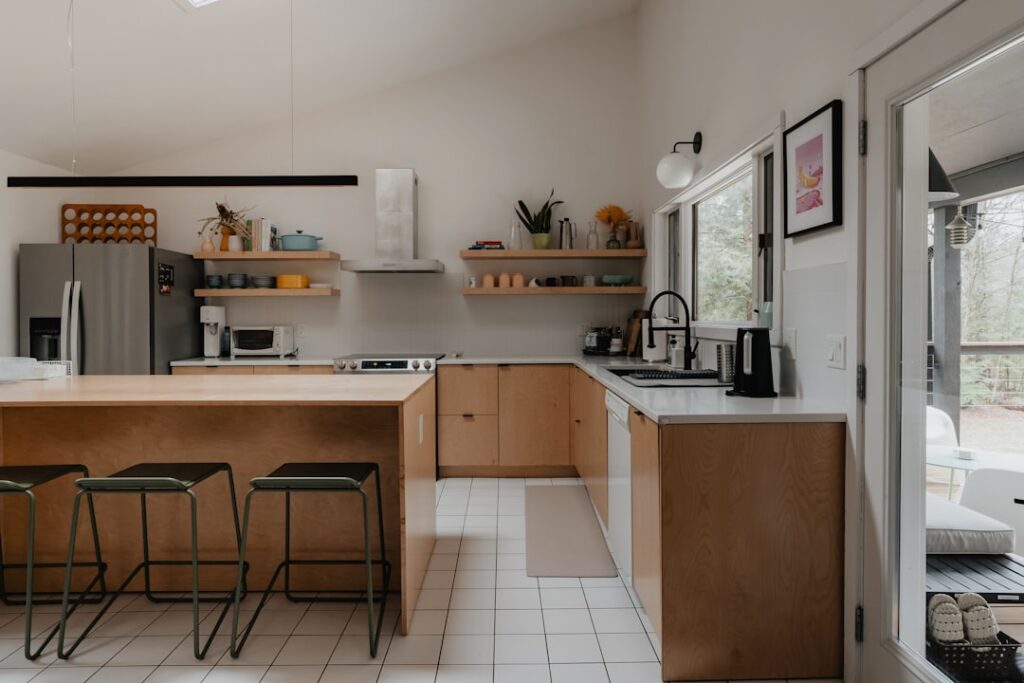Timeless Beauty for Your Home: Traditional Kitchen Design
Traditional kitchen remodel ideasfocus on creating warm, inviting spaces that blend classic aesthetics with practical functionality. For homeowners seeking this timeless style, here are the key elements to consider:
- Cabinetry: Painted cabinets with raised panels, glass-front options, or beadboard details
- Countertops: Granite, marble, or quartz with decorative edge profiles
- Flooring: Hardwood, stone tile, or high-quality laminate
- Hardware: Bronze, copper, or brass fixtures with detailed designs
- Details: Crown molding, corbels, and decorative trim work
Traditional kitchens remain popular because they create a cozy, familiar atmosphere while offering flexibility for personalization. As designer Rita Konig notes, “Think hard about how you will move around it. I make sure that the dishwasher and kitchen bin are on either side of the kitchen sink.”
A traditional kitchen remodel doesn’t mean you’re stuck in the past. Today’s traditional designs thoughtfully blend classic elements with modern conveniences, creating spaces that feel both timeless and current. The traditional style emphasizes quality craftsmanship, functional layouts, and materials that stand the test of time.
The beauty of traditional design lies in its versatility—it works well in homes of various ages and architectural styles. Whether you live in a historic property or a newer build, a traditional kitchen can become the warm, inviting heart of your home.
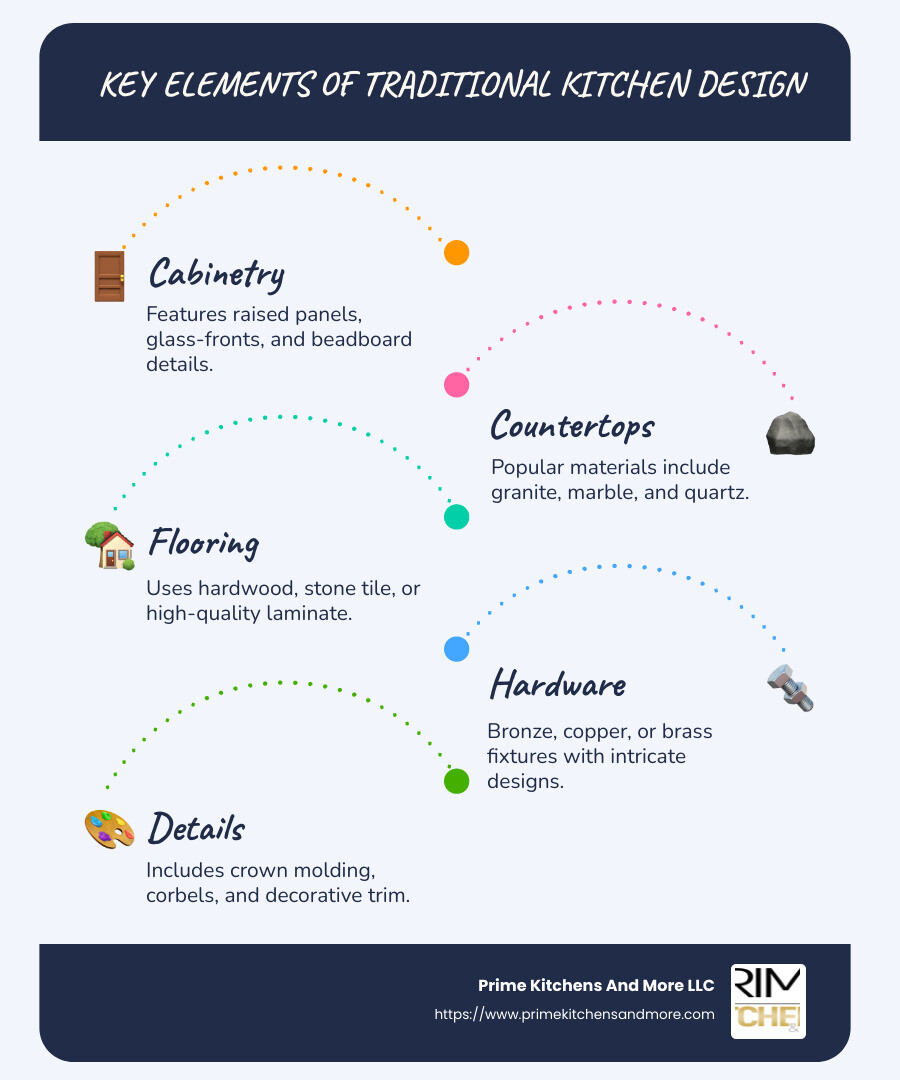
What Defines a Traditional Kitchen?
When you walk into a traditional kitchen, there’s an immediate sense of warmth and timelessness that wraps around you like a cozy blanket. These spaces aren’t about chasing the latest trends – they’re about creating a heartfelt gathering place that feels as relevant today as it will decades from now.
Traditional kitchens draw inspiration from historical design periods while maintaining a classic appeal that rarely goes out of style. They’re characterized by fine craftsmanship, attention to detail, and materials that age beautifully over time.
As one design expert puts it, “A traditional style kitchen is classic, homey, and familiar. It features signature elements like raised panel cabinetry, decorative details like crown molding, and time-tested materials like wood, brick, and stone.” These elements work together to create spaces that feel both polished and comfortable.
What truly gives traditional kitchens their distinctive character is the thoughtful attention to detail. From intricate crown moldings that draw the eye upward to decorative hardware that feels substantial in your hand, every element is chosen with care to create a cohesive, inviting space that stands the test of time.
For more insights on traditional kitchen design elements, check outWhat Defines a Traditional Kitchen?from HGTV.
Key Traditional Kitchen Remodel Ideas and Materials
When planning yourtraditional kitchen remodel ideas, it’s important to focus on quality materials and timeless design elements that will look as beautiful in ten years as they do today.
The foundation of any traditional kitchen starts with well-crafted cabinetry. Look for painted cabinets with raised-panel or inset doors that showcase detailed profiles. White and cream finishes remain perennially popular, creating a bright, clean backdrop that allows other elements to shine. Many homeowners are also embracing rich wood tones like cherry or walnut to add warmth and character.
For countertops, natural materials reign supreme in traditional designs. Granite remains a popular choice for its durability and natural beauty, while marble adds neat veining that’s hard to resist (despite its higher maintenance needs). For budget-conscious remodels, today’s laminates offer incredible realism at a fraction of the cost.
Hardwood floors bring unmistakable warmth to traditional kitchens. Oak, maple, and cherry are all excellent choices that develop beautiful patina over time. In areas where moisture is a concern, consider porcelain tiles that mimic the look of wood while offering superior water resistance.
Decorative moldings are the finishing touches that lift traditional kitchens from nice to extraordinary. Crown molding, chair rails, and cabinet trim work together to create a finished, custom look. These architectural details add dimension and character that simply can’t be achieved with more minimalist designs.
Classic fixtures complete the traditional look. Look for bridge-style faucets, bin pulls, and cup handles in warm metals like brass, bronze, or copper. These small details make a big impact on the overall feel of your kitchen.
Popular Traditional Kitchen Layouts
The layout of your kitchen significantly impacts both its functionality and charm. In traditional kitchens, function always works hand-in-hand with beauty.
The L-shaped layout remains one of the most versatile configurations, working beautifully in most spaces while providing an efficient work triangle. This layout is particularly effective for open-concept homes, as it allows for easy flow between the kitchen and adjacent living areas while maintaining clear traffic patterns.
For larger kitchens, the U-shaped layout maximizes storage and counter space by utilizing three walls. This configuration creates an efficient work triangle and can comfortably accommodate multiple cooks working simultaneously – perfect for families who love to prepare meals together.
The galley kitchen layout, named after the cooking areas on ships, features parallel counters and provides highly efficient workspace in smaller homes. Despite its compact footprint, a well-designed galley kitchen can be surprisingly functional and neat.
Regardless of which layout you choose, the classic work triangle concept – positioning the refrigerator, sink, and stove in a triangle formation – remains fundamental to good kitchen design. For optimal efficiency, each leg of the triangle should measure between 4 and 9 feet, with the total perimeter between 13 and 26 feet.
At Prime Kitchens And More LLC, we’ve helped countless Orlando homeowners transform ordinary kitchens into extraordinary traditional spaces that balance beauty with practicality. Our 15 years of experience ensures that your kitchen will not only capture the timeless appeal of traditional design but will function perfectly for your family’s unique needs.
Incorporating Modern Elements into a Traditional Kitchen

There’s something magical about a kitchen that honors the past while embracing the present. That’s exactly what makestraditional kitchen remodel ideasso exciting today—they give you the chance to create spaces that feel timeless yet completely functional for modern living.
I recently visited a stunning Massachusetts home where designer Nancy Hanson had worked her magic. She’d stripped away dated 1980s elements and replaced them with features that felt appropriate to the home’s history, while cleverly incorporating modern conveniences the family couldn’t live without. As she explained while showing me around, “Traditional kitchens aren’t stuck in any particular era—they’re about quality craftsmanship, functional layouts, and materials that stand the test of time.”
Traditional Kitchen Remodel Ideas for Blending Modern Elements
Want to create your own perfect blend of old and new? Here’s how to strike that balance:
Hidden technologyis your secret weapon in a traditional kitchen. Today’s appliances offer incredible functionality without compromising your kitchen’s classic look. Many of our Orlando clients opt for panel-ready refrigerators and dishwashers that we fit with cabinet fronts to maintain that seamless traditional appearance. As one homeowner told me after we completed her Winter Park remodel, “I love that my kitchen looks like it could be from 1920, but performs like it’s 2023!”
Open shelvingbrings a fresh, contemporary feel while still working beautifully in traditional spaces. In a recent Lake Nona project, we installed beadboard-backed open shelves to address a challenging sloped ceiling. The homeowners now use these shelves to display their cherished collection of blue and white pottery—a perfect marriage of traditional materials with modern display concepts.
Lighting makes all the differencewhen blending styles. Consider updating traditional chandeliers or pendants with fixtures that maintain classic silhouettes but feature contemporary finishes. One of my favorite changes involved replacing a dated brass chandelier with a similar shape in matte black—same traditional form, completely different feel.
Color can bridge the gapbetween traditional and contemporary. While classic kitchens often feature neutral palettes, incorporating a bold accent color adds modern flair without disrupting the traditional bones. A client in Winter Garden fell in love with a striking red island we installed as the centerpiece of her otherwise classic white kitchen—it’s traditional with just the right amount of personality.
“Traditional kitchens offer flexibility by blending timeless design elements with the opportunity for bold accent choices.”
Mixed materialsadd depth and interest that feels both collected and current. Try pairing marble countertops with a butcher block island, or mixing metal finishes for hardware. In Windermere, we recently completed a kitchen with brass pendants, matte black cabinet hardware, and stainless appliances—the mix feels intentional rather than matched, giving the space character and contemporary appeal.
Energy-efficient solutionscan be seamlessly integrated into traditional designs. From LED lighting tucked into crown molding to high-efficiency windows that maintain historical profiles, today’s green technologies don’t have to compromise your kitchen’s traditional aesthetic.
Updated backsplashesoffer another opportunity to introduce modern elements. While subway tile remains a classic choice, consider contemporary variations like elongated tiles, handmade ceramics with slight imperfections, or even a dramatic marble slab backsplash for a modern interpretation of traditional materials.
One of my favorite projects illustrates this blend perfectly—a kitchen we completed in Winter Park for a family of five living in a 1930s home. They wanted to honor their home’s heritage while creating a more functional space for modern family life. We installed classic white inset cabinetry but incorporated contemporary conveniences like a large island with a microwave drawer, soft-close hardware, and integrated charging stations hidden in drawers. The result? A kitchen that respects the home’s past while fully embracing its future.
The beauty of blending traditional and modern elements is that you get a kitchen that feels timeless rather than trendy—one that will look as good in twenty years as it does today.
Choosing the Right Color Schemes for Your Traditional Kitchen Remodel
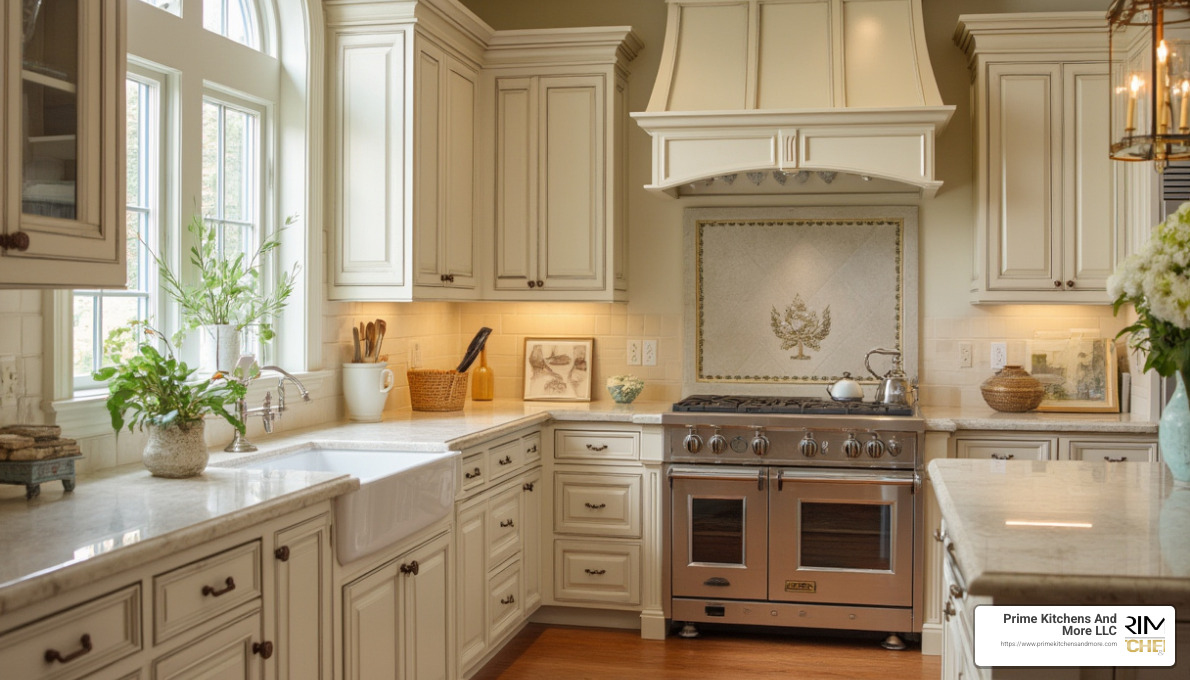
The colors you choose for your kitchen set the entire mood of the space. While trendy kitchens might accept bold, experimental colors,traditional kitchen remodel ideastypically lean toward timeless palettes that create a sense of warmth and permanence – colors that feel as welcoming today as they will a decade from now.
As we often tell our Orlando clients, “Neutral kitchens never go out of style.” Whites, creams, beiges, taupes, and soft grays create versatile foundations that stand the test of time while allowing your personality to shine through accessories and accents.
The all-white kitchen remains a perennial favorite in traditional design. It creates a bright, clean canvas that makes even smaller kitchens feel more spacious. To prevent that pristine white from feeling too clinical, we recommend incorporating warm wood tones through flooring, an island countertop, or exposed ceiling beams – elements that add warmth and texture.
For homeowners wanting something a bit softer than stark white, cream and beige tones offer a beautiful alternative. These warm neutrals create a cozy, inviting atmosphere while maintaining that light, airy feel that’s so desirable in Florida homes. They pair beautifully with natural materials like wood and stone, creating kitchens that feel both neat and comfortable.
The classic navy and white combination has surged in popularity among our traditional kitchen clients. Navy lower cabinets paired with white upper cabinets create visual interest while remaining completely timeless. This approach grounds the space while keeping it feeling open and airy above.
Sage green has historical roots in traditional kitchens but feels surprisingly fresh today. As one Winter Park client remarked after we completed her sage green kitchen, “It feels both classic and current at the same time – exactly what I wanted.”
Many of our clients are embracing the two-tone approach – using different colors for upper and lower cabinets or highlighting an island with a contrasting hue. This strategy adds visual interest while maintaining traditional appeal. One Lake Mary project featured green-gray lower cabinets with light gray uppers, creating beautiful contrast while highlighting architectural details.
Enhancing with Paint and Backsplashes
Paint and backsplashes offer tremendous opportunity to transform your kitchen without extensive reconstruction – making them perfect fortraditional kitchen remodel ideaswhen you’re working with budget constraints.
Cabinet paint can completely revitalize dated woodwork. For a truly traditional look that will stand the test of time, considercream or off-whitefor a versatile foundation,muted blues or greensfor subtle color that feels classic, orrich, deep toneslike navy or hunter green for more dramatic traditional spaces.
When selecting paint, quality matters tremendously in kitchens. We always recommend high-quality cabinet-grade formulations that will withstand years of cooking, cleaning, and daily life. In Florida’s humid climate, semi-gloss or satin finishes offer the perfect balance of beauty and practicality – something our Orlando clients particularly appreciate.
The right backsplash serves as both practical protection and a design focal point. Subway tile remains the quintessential traditional choice, but don’t feel limited to basic white rectangles. Beveled edges, handmade tiles with slight irregularities, or subtle color variations can add personality while maintaining that classic look.
Natural stone backsplashes, particularly in traditional patterns like herringbone or basketweave, add elegance and texture. We recently completed a Winter Park kitchen featuring Carrara marble in a herringbone pattern that beautifully complemented the home’s 1920s architecture.
For a different take on traditional, consider beadboard or wainscoting. These wood panel treatments add architectural interest and can be painted to complement or contrast with cabinetry. They’re particularly effective in creating that “farmhouse traditional” look that many homeowners love.
Hand-painted tiles offer another way to personalize your traditional kitchen. We worked with a Windermere homeowner to transform her dated 1990s kitchen with cream-colored cabinets and a striking custom backsplash featuring hand-painted tiles in a traditional Portuguese pattern. The result felt both timeless and uniquely personal – exactly what a traditional kitchen should be.
For more inspiration on beautiful traditional kitchen designs, explore 12 Kitchen Remodeling Ideas & Designs from Home Depot’s design experts.
Maximizing Storage in a Traditional Kitchen Layout
When it comes to traditional kitchens, there’s a delicate balance between showcasing beautiful design elements and keeping everyday items neatly tucked away. While modern kitchens might accept open shelving and visible storage, traditional spaces typically favor a more organized, contained approach that keeps countertops clear and clutter hidden.
The charm of a traditional kitchen often lies in its tidy, well-organized appearance. As one homeowner put it after her recent remodel, “I never knew how much joy I could get from simply being able to find everything in my kitchen!” This sense of order doesn’t happen by accident—it requires thoughtful planning during yourtraditional kitchen remodel ideasphase.
Many of our Orlando clients come to us with the same concern: they love the warm, classic look of traditional kitchens but worry about having enough storage for modern cooking equipment and pantry items. The good news is that traditional design offers plenty of creative storage opportunities that maintain classic appeal while meeting contemporary needs.
Clever Traditional Kitchen Remodel Ideas for Storage
One of the most effective storage strategies for traditional kitchens is maximizing vertical space with floor-to-ceiling cabinetry. These tall cabinets not only provide ample storage but also draw the eye upward, making the room feel larger. Upper cabinets are perfect for seasonal items or special occasion dishware, and adding glass fronts to these higher cabinets creates a beautiful display space for heirloom pieces while maintaining the traditional aesthetic.
Inside your cabinets and drawers, custom organizers can transform chaotic spaces into models of efficiency.Drawer dividerskeep utensils and cooking tools neatly arranged, whilespecialized insertscan organize everything from spices to cutting boards. One Lake Mary client told us, “The custom spice drawer organizer changed my cooking experience completely—I can finally see and reach everything at once!”
Corner cabinetsoften present storage challenges in traditional layouts, but solutions like lazy Susans, diagonal drawers, or specialized corner pull-outs can reclaim this potentially wasted space. During a recent Winter Park renovation, we installed a pull-out corner system that the homeowner now describes as “the most functional storage area in my entire kitchen.”
For small appliances that you use regularly but don’t want cluttering your countertops,appliance garagesoffer the perfect solution. These specialized cabinets with retractable doors keep toasters, coffee makers, and mixers accessible but hidden when not in use—maintaining those clean lines that traditional kitchens are known for.
If your home’s layout allows, consider incorporating abutler’s pantrybetween your kitchen and dining area. This traditional feature provides additional storage and workspace that’s particularly valuable for entertaining. As one designer playfully noted during a recent Windermere project, this space works wonderfully “with or without the actual butler.”
Kitchen islandsdeserve special attention in traditional designs, as they offer tremendous storage potential through drawers, cabinets, or specialized features like wine refrigerators. In traditional kitchens, islands often feature furniture-style details like decorative legs or beadboard panels that improve both function and beauty while providing valuable storage space.
For those who appreciate both practicality and display,hanging pot racksserve dual purposes in traditional kitchens. They keep frequently used cookware easily accessible while showcasing beautiful copper or cast iron pieces that complement traditional design elements.
At Prime Kitchens And More LLC, we recently worked with a family in Maitland who was struggling with a cramped, inefficient kitchen. By reconfiguring their layout to include a large island with deep drawers, adding floor-to-ceiling cabinetry, and incorporating specialized storage solutions, we doubled their functional storage while enhancing the traditional aesthetic they loved. The change wasn’t just about adding space—it was about creating thoughtful, organized storage that made cooking and gathering more enjoyable.
Whether you’re planning a complete kitchen overhaul or looking for ways to improve your existing space, smart storage solutions can transform how you experience your traditional kitchen every day. The beauty of traditional design is that it allows for these practical elements while maintaining the timeless, warm aesthetic that makes these kitchens so beloved.
Lighting to Improve the Traditional Kitchen Aesthetic

Nothing transforms a traditional kitchen quite like thoughtful lighting. It’s like adding the perfect piece of jewelry to a classic outfit – it lifts everything around it. In our 15 years of creating dream kitchens across Orlando, we’ve seen how the right lighting can take a beautiful traditional kitchen and make it absolutely breathtaking.
The secret to successful traditional kitchen lighting isn’t just choosing pretty fixtures (though that’s certainly part of it!). It’s about creating layers of light that work together to highlight your kitchen’s best features while ensuring you can actually see what you’re chopping for dinner.
A well-designed lighting plan for yourtraditional kitchen remodel ideasshould include three essential layers. First,ambient lightingprovides that overall glow that fills the room – typically from recessed ceiling fixtures, flush-mounts, or a stunning chandelier. For a truly traditional feel, look for fixtures with classic profiles in warm finishes like aged brass or antique bronze.
Next comestask lighting, your kitchen’s workhorse. This includes under-cabinet lights that illuminate countertops, pendant lights that shine down on islands or sinks, and perhaps some well-placed recessed lights above key work areas. Modern LED strip lighting works beautifully here – it’s energy-efficient and provides clear, consistent light without disrupting your traditional aesthetic.
The final layer,accent lighting, adds that special touch of magic. This might be interior cabinet lighting that makes your grandmother’s china collection glow behind glass cabinet doors, or strategic sconces that highlight architectural details like crown molding or a decorative backsplash.
“Layered lighting is really the secret ingredient in a traditional kitchen,” explains one of our designers. “It not only highlights all those beautiful traditional details you’ve invested in, but it creates that warm, welcoming ambiance that makes people want to gather in the kitchen.”
Selecting Light Fixtures That Complement Your Traditional Kitchen
The fixtures themselves speak volumes in a traditional kitchen. They’re not just functional items – they’re decorative elements that help tell your home’s story.
Aclassic chandeliercan become the crown jewel of your traditional kitchen. Hung above an island or breakfast nook, it adds instant elegance and creates a natural focal point. For truly traditional spaces, look for designs with candle-style lights, crystal accents, or metal finishes with a bit of patina that suggests they’ve been lighting family gatherings for generations.
Pendant lightsoffer incredible versatility in traditional kitchens. Over islands and sinks, they provide essential task lighting while adding personality. We often recommend pendants with clear or seeded glass for traditional spaces – they offer a timeless look that complements rather than competes with other design elements. One of our Lake Mary clients chose beautiful bell-shaped glass pendants with brass detailing that perfectly echoed the hardware on their traditional cabinetry.
Don’t overlook the charm ofwall sconcesin your traditional kitchen design. These fixtures add a warm glow at eye level and can highlight architectural features or create ambiance in dining areas. They’re particularly effective in butler’s pantries or transitional spaces between your kitchen and dining room.
While primarily functional,under-cabinet lightingdramatically improves your ability to work safely and efficiently. Today’s LED options can be seamlessly integrated into even the most traditional designs, providing crisp, clear light without visible fixtures or wires.
We recently completed a kitchen change in Winter Garden where lighting made all the difference. The homeowners had beautiful traditional bones to work with – crown molding, raised-panel cabinetry, and a classic layout. We installed an antique brass chandelier with a slightly weathered finish over their island, complementary pendant lights above the sink, and strategically placed recessed lighting throughout.
The magic happened when we added under-cabinet LED lighting to illuminate work surfaces and interior cabinet lighting to showcase their collection of vintage blue and white china behind glass-front cabinets. The layered approach created a kitchen that honored traditional design while functioning perfectly for a modern family.
When selecting fixtures for your traditional kitchen, scale matters tremendously. An oversized chandelier or statement pendants can serve as dramatic focal points, but they should be proportional to your space. As a general guideline, pendants and chandeliers should hang about 30-36 inches above islands or tables – high enough not to block conversation but low enough to properly illuminate the surface below.
At Prime Kitchens And More LLC, we love helping Orlando homeowners find that perfect balance of traditional charm and modern functionality in their kitchen lighting. Sometimes it’s the fixture you fall in love with that drives other design decisions, and sometimes it’s the finishing touch that pulls everything together. Either way, thoughtful lighting ensures your traditional kitchen looks as beautiful at midnight as it does at noon.
Cost-Effective Traditional Kitchen Remodel Ideas
Creating a beautiful traditional kitchen doesn’t have to empty your bank account. With some strategic planning and clever design choices, you can achieve that timeless look you love without the premium price tag.
The reality ofkitchen remodelingcosts can be eye-opening. Industry data shows that a midrange kitchen remodel typically costs between $65,000 and $75,000, while more extensive upscale projects can jump to $130,000-$145,000. But don’t let those numbers discourage you! There are plenty of ways to get that traditional charm for less.
One of the smartest approaches is to work with what you already have.Cabinet refacingoffers dramatic change at roughly half the cost of full replacement. If your cabinet boxes are structurally sound, new doors and drawer fronts can completely change their appearance while keeping your budget intact.
For many Orlando homeowners we’ve worked with, astrategic cabinet replacementapproach works wonders. This might mean replacing only the most visible or damaged cabinets while painting or refacing the rest to match. The savings can be substantial, and guests will never know the difference!
Never underestimate the power of paint. A fresh coat in a classic cream, soft white, or muted color can breathe new life into tired cabinetry. This is particularly effective when updating oak or other wood cabinets to a more current painted finish. As one designer client of ours put it, “The paint change was so dramatic, my friends thought I had installed all new cabinetry!”
Sometimes the smallest details make the biggest impact.Hardware updateslike new knobs, pulls, and hinges can dramatically change your cabinets’ appearance with minimal investment. For that authentic traditional look, consider bin pulls, cup pulls, or detailed knobs in warm finishes like brass, bronze, or copper. These small pieces add character and period-appropriate charm.
While natural stone countertops are beautiful, several alternatives can provide a traditional look without the hefty price tag. Quality quartz offers marble-like appearance with better durability, while today’s premium laminates have come a long way from the products of yesteryear. Even butcher block can provide warmth and traditional appeal at a fraction of stone’s cost.
One of the most visible ways to transform your kitchen is with updated lighting. Replacing outdated fixtures with traditional-style pendants, chandeliers, or sconces can completely change the feel of your space without requiring extensive electrical work. A beautiful lantern pendant over an island or a classic chandelier above a breakfast nook becomes an instant focal point.
Budget-Friendly Materials and DIY Ideas
For the truly budget-conscious homeowner, several DIY approaches can stretch your remodeling dollars even further.
Today’slaminate countertopsbear little resemblance to their predecessors. Premium options offer remarkably realistic stone looks, complete with decorative edges and convincing patterns. We recently helped a Lake Mary family achieve the look of marble with a high-quality laminate that saved them thousands while still delivering that traditional aesthetic they wanted.
Flooring presents another opportunity for significant savings.Luxury vinyl plank (LVP) and tile (LVT)have advanced tremendously in recent years, offering the look of hardwood or stone with better moisture resistance—perfect for Florida kitchens! These products are often more DIY-friendly than traditional materials, further reducing your overall costs.
Installing a tile backsplash is a manageable weekend project for many homeowners. Traditional options like subway tile remain relatively inexpensive and straightforward to install. One client in Winter Park created a stunning traditional backsplash using classic white subway tiles with a simple running bond pattern—timeless, beautiful, and budget-friendly.
Sometimes less is more—and less expensive!Removing some upper cabinetsand replacing them with open shelving can save money while creating display space for beautiful dishware or collectibles. This approach works particularly well in traditional kitchens, where showcasing heirloom pieces adds character and personal history.
Before replacing elements entirely, consider refinishing what you have. Existing hardwood floors can often be sanded and refinished for a fraction of replacement costs. Similarly, a porcelain farmhouse sink—a traditional kitchen staple—can usually be professionally reglazed rather than replaced.
| Update | Average Cost | Traditional Style Options |
|---|---|---|
| Cabinet Refacing | $4,000-$9,000 | Raised panel doors, beadboard inserts, glass-front options |
| New Hardware | $200-$600 | Bin pulls, cup pulls, detailed knobs in brass or bronze |
| Laminate Countertops | $1,500-$4,000 | Stone-look patterns with decorative edges |
| Luxury Vinyl Flooring | $2,000-$5,000 | Wood-look planks in traditional species like oak or walnut |
| Tile Backsplash | $600-$1,200 | Subway tile, beadboard, or traditional patterns |
| New Lighting Fixtures | $500-$2,000 | Lantern pendants, traditional chandeliers, sconces |
At Prime Kitchens And More LLC, we’ve helped countless homeowners throughout Orange and Seminole Counties create beautifultraditional kitchen remodel ideaswithout breaking their budgets. We understand that every dollar counts, and we’re experts at determining which updates will give you the most bang for your buck. Whether you’re planning a complete renovation or strategic updates, we can guide you through creating a traditional kitchen that looks like a million bucks—without spending nearly that much.
Incorporating Antique or Vintage Elements
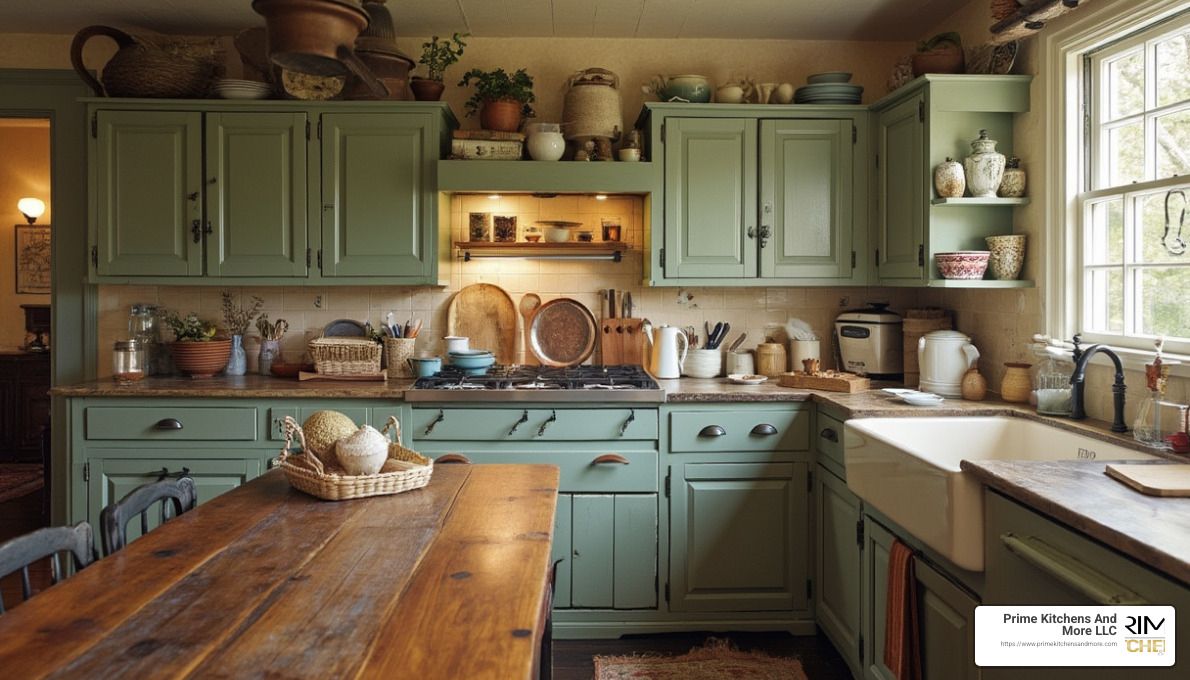
There’s something magical about walking into a kitchen that tells a story through its pieces. When you incorporate antique or vintage elements into yourtraditional kitchen remodel ideas, you’re not just designing a space—you’re creating a narrative that spans generations.
These cherished pieces do more than just look pretty. They connect us to the past while serving very practical purposes in our modern lives. As one designer beautifully put it, “Integrating traditional design principles such as the 70‐year-old work triangle with modern storage solutions provides a unique blend of classic and contemporary design.”
Benefits of Antique Additions in Your Traditional Kitchen Remodel
When you welcome antique pieces into your kitchen, you’re gaining so much more than just decorative elements. First and foremost, these items bringunique characterthat mass-produced pieces simply can’t match. Each scratch, patina, and wear mark tells a story of meals prepared and memories made long before your time.
There’s also something wonderfullysustainableabout giving new life to old pieces. In today’s throwaway culture, choosing to restore and reuse quality items keeps beautiful craftsmanship out of landfills while reducing demand for new manufacturing. Your grandmother would certainly approve!
Thequality craftsmanshipfound in many antique pieces often surpasses what we see in modern furniture. Hand-carved details, dovetail joints, and solid wood construction were standard features in earlier eras—details that would come with luxury price tags today if made new.
Vintage elements naturally becomedesign focal pointsin your kitchen. When we incorporated a restored 1920s farmhouse sink into a Lake Mary home recently, it immediately became the conversation piece that guests gravitated toward. These unique elements make your kitchen memorable in ways that standard fixtures never could.
Many homeowners are surprised to learn that quality antiques oftenretain or increase their valueover time, unlike many new items that depreciate the moment they’re installed. That gorgeous vintage chandelier might actually be an investment!
The beauty of working antiques into your kitchen lies in the endless creative possibilities. A vintage dresser transformed into a kitchen island brings immediate warmth and character. We helped a Winter Park family convert a cherished oak buffet into a stunning island, topping it with marble to create a functional prep space while preserving the beautiful carved details they’d loved for generations.
Vintage lightingtransforms the mood of a kitchen instantly. Antique chandeliers, pendants, or sconces add undeniable charm and can be safely rewired to meet modern standards. One Windermere homeowner worked with our team to incorporate her grandmother’s crystal chandelier above her kitchen island—now it casts beautiful patterns across her cooking space while honoring her family heritage.
Salvaged architectural elementstell stories through their very existence. Exposed beams from an old barn, vintage doors repurposed as pantry entrances, or ornate corbels supporting open shelving all bring history and soul to your space. These elements feel authentic because they are authentic.
For those who collectantique dishware and accessories, a traditional kitchen remodel offers the perfect opportunity to showcase these treasures. Glass-front cabinets or carefully placed open shelving puts your grandmother’s china or that flea market copper cookware collection on display, adding personal touches that reflect your interests and family history.
Some homeowners go all-in withvintage appliancesas stunning focal points. We’ve helped clients incorporate everything from restored 1950s refrigerators to gleaming vintage stoves that become the heart of their kitchens. If authentic vintage isn’t practical for your needs, companies like Big Chill and Smeg offer new appliances with vintage aesthetics but thoroughly modern functionality.
Reclaimed materialsbring warmth and history even to brand-new construction. Flooring, countertops, or shelving made from reclaimed wood carries the rich patina that only comes with age. Each board tells a story of its previous life—perhaps as part of a barn, factory, or another home entirely.
We recently helped a family in Winter Park create a kitchen that felt collected over decades rather than installed all at once. We designed custom cabinetry around a stunning antique hutch they’d inherited, installed lighting fixtures inspired by early 20th century designs, and incorporated their collection of copper cookware as both functional tools and beautiful decor. The space feels authentic, lived-in, and deeply personal—exactly what a traditional kitchen should be.
At Prime Kitchens And More LLC, we love helping Orlando-area homeowners find that perfect balance between honoring the past and embracing modern convenience. Whether you have family heirlooms to incorporate or need help sourcing the perfect vintage pieces, we’ll help you create a kitchen with both history and heart.
Why Choose a Traditional Kitchen Over a Modern One?
With so many design styles available today, you might wonder why a traditional kitchen is worth considering. While contemporary and modern kitchens certainly have their appeal, traditional designs offer distinct advantages that continue to make them a popular choice for homeowners throughout the Orlando area and beyond.
Traditional kitchens havetimeless appealthat endures through changing trends. Unlike contemporary designs that might look dated within a few years, traditional kitchens maintain their charm for generations. This makes them an excellent long-term investment, particularly if you’re planning to stay in your home for many years or are concerned about future resale value.
Thewarmth and comfortof traditional kitchens is immediately noticeable when you walk into one. With their rich details, natural materials, and familiar elements, these spaces feel instantly welcoming and lived-in. As one designer puts it, “A traditional style kitchen is classic, homey, and familiar.” This inviting quality makes traditional kitchens natural gathering places for family and friends.
I love howdesign flexibilityis built into the traditional aesthetic. These kitchens can incorporate elements from various historical periods, allowing for personalization while maintaining a cohesive look. Whether your home is colonial, Victorian, craftsman, or farmhouse style, a traditional kitchen can be custom to complement its architecture perfectly.
Traditional kitchens are built aroundfunctional layoutsthat have stood the test of time. The classic work triangle concept—connecting the refrigerator, sink, and stove in an efficient arrangement—wasn’t developed on a whim. It evolved through decades of understanding how people actually use their kitchens. These tried-and-true layouts create spaces that work beautifully for both everyday cooking and special occasions.
Thequality materialsused in traditional kitchens are another significant advantage. Natural wood, stone, and metal not only look beautiful initially but tend to age gracefully over time. As one designer notes, “Quartersawn oak has beautiful fine, tight grain. It’s more expensive, but it’s worth it.” These materials can often be maintained or restored rather than replaced, making them more sustainable long-term investments.
When it comes time to sell your home, atraditional kitchen’s resale valueoften exceeds that of trendier styles. Their classic styling appeals to a broad range of potential buyers, unlike highly personalized contemporary designs that might limit your home’s appeal. Real estate agents consistently report that well-designed traditional kitchens are a strong selling point.
The Enduring Popularity of Traditional Kitchens
Despite constantly changing trends,traditional kitchen remodel ideashave maintained their popularity over decades. According to industry professionals, they remain one of the most requested styles inkitchen remodelingprojects.
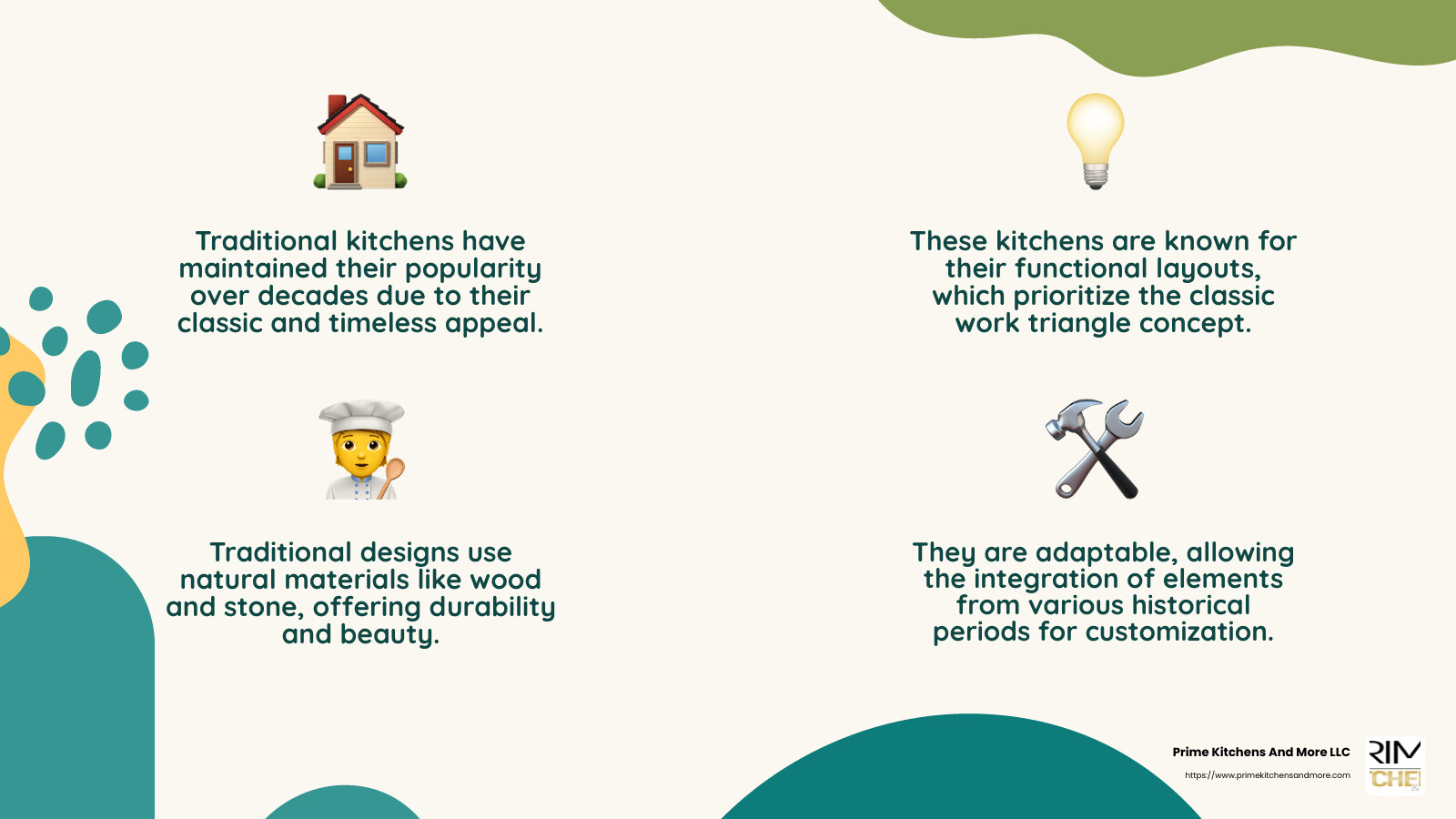
What makes traditional kitchens so enduringly popular? Beyond their visual appeal, they offer practical benefits that align with how families actually use their kitchens. They provide ample storage for everything from everyday dishes to special occasion serveware. Their durable surfaces stand up to the rigors of daily cooking and cleaning. And their thoughtful layouts facilitate both serious meal preparation and casual gatherings.
Here in Central Florida, we’ve noticed traditional kitchens work particularly well with our lifestyle. They offer the perfect blend of formal elegance and casual comfort that complements our unique mix of Southern hospitality and relaxed Florida living. The natural materials used in traditional designs also tend to feel cooler and more inviting in our warm climate.
At Prime Kitchens And More LLC, we’ve designed and built hundreds of traditional kitchens throughout Orlando, Winter Park, Windermere, and surrounding communities. Our clients consistently tell us that these spaces not only look beautiful when first completed but continue to bring them joy years later. There’s something deeply satisfying about a kitchen that feels both beautiful and timeless—a space that will welcome family gatherings for generations to come.
Frequently Asked Questions about Traditional Kitchen Remodels
What Defines a Traditional Kitchen Style?
When you walk into a traditional kitchen, you immediately feel that sense of timeless warmth and elegance. These kitchens aren’t about chasing the latest trends – they’re about creating spaces that feel like home for generations to come.
Traditional kitchens are defined by their attention to detail and quality craftsmanship. You’ll notice cabinetry with raised panels or inset doors that showcase fine woodworking. Natural materials dominate the space – beautiful woods, natural stone countertops, and metal fixtures with character and weight.
Look up, and you’ll likely see architectural details that modern kitchens often skip – crown molding framing the ceiling, decorative corbels supporting shelves or range hoods, and thoughtful trim work that adds dimension and interest. As one design expert puts it, “Traditional kitchens feature signature elements like raised panel cabinetry, decorative details like crown molding, and time-tested materials like wood, brick, and stone.”
The color palette tends to favor neutrals – warm whites, creams, and beiges that create a timeless backdrop. But don’t mistake neutral for boring! Traditional kitchens often incorporate rich accent colors that add depth and personality.
Perhaps most distinctive is the furniture-like quality of traditional kitchen elements. Islands might feature decorative legs, giving them the appearance of freestanding furniture. This attention to detail creates spaces that feel collected and curated rather than mass-produced.
How Can I Make My Traditional Kitchen More Modern?
Many homeowners love the warmth of traditional design but want to incorporate modern elements for a fresh, updated look. The good news is that traditional and modern can blend beautifully with the right approach.
Start bysimplifying some detailswhile keeping others. You might choose less ornate moldings or hardware for a cleaner look that bridges traditional and contemporary styles.Updated color schemescan work wonders too – consider painting traditional cabinetry in deeper blues, sage greens, or warm grays rather than classic cream or white.
Modern materialscan complement traditional elements beautifully. A sleek quartz countertop paired with traditional wood cabinetry creates an interesting contrast.Contemporary lightingcan transform the space – consider fixtures that honor traditional silhouettes but feature cleaner lines or unexpected materials.
Yourappliance choicesmake a big difference too. Professional-grade stainless steel appliances or fully integrated models that disappear behind cabinetry panels offer modern performance while maintaining the kitchen’s traditional aesthetic.
If your layout allows,opening up the spaceby removing walls or some upper cabinets creates a more contemporary feel while still showcasing traditional elements. One designer notes, “Integrating modern elements such as unique lighting fixtures, industrial touches, or boldly painted walls can refresh a traditional kitchen without losing its classic appeal.”
In Orlando’s historic neighborhoods, we’ve helped many homeowners blend old and new. One Winter Park family maintained their 1920s home’s character while creating a more functional kitchen by keeping traditional cabinet styles but opening the layout to connect with their dining area – creating a space that honors history while meeting contemporary needs.
Are Traditional Kitchen Cabinets Still in Style?
Absolutely!Traditionalkitchen cabinetsremain consistently popular and are considered a truly timeless choice. According to design experts, “Traditionalkitchen cabinetsremain ever-present because their classic design does not easily go out of style, despite more modern trends.”
What makes traditional cabinets endure year after year is their quality construction, detailed craftsmanship, and remarkable versatility. They work beautifully in homes of various architectural styles – from colonial and craftsman to Mediterranean and contemporary. With new hardware, fresh paint colors, or updated interior fittings, traditional cabinets can reflect current trends without requiring complete replacement.
The most popular traditional cabinet styles include raised panel doors with detailed profiles that add dimension and shadow lines. Inset doors that sit flush with the cabinet frame offer a clean, precise look that showcases fine craftsmanship. Many homeowners choose to incorporate beadboard or glass panel inserts on select cabinets to add visual interest and display opportunities.
For Florida homeowners, traditional cabinets offer practical benefits beyond their good looks. Their solid construction stands up well to our humidity, and their timeless style complements both historic Winter Park bungalows and newer properties throughout Orange and Seminole Counties.
At Prime Kitchens And More LLC, we’ve installed hundreds of traditional cabinets in homes across Orlando, and our clients consistently report that they love how these cabinets feel both classic and current – never dated or trendy. With proper care, traditional cabinets can look beautiful for decades, making them not just a style choice but a smart investment in your home.
Conclusion
There’s something truly special about a traditional kitchen—a space that manages to feel both timeless and perfectly suited to modern life. When you undertake atraditional kitchen remodel, you’re not just updating a room; you’re creating a warm, inviting heart for your home that will welcome family and friends for years to come.
The beauty of traditional design lies in its perfect balance. It honors the past through classic elements like raised panel cabinetry, crown molding, and natural materials, while still embracing the conveniences that make today’s kitchens so functional. Your traditional kitchen can be both beautiful and hardworking—a place where you can prepare holiday feasts, help with homework, or simply enjoy a quiet cup of coffee.
What makes traditional kitchens so enduring is their attention to detail. Each element—from the profile of your cabinet doors to the finish on your hardware to the pattern of your backsplash—contributes to creating a cohesive, welcoming space. These thoughtful touches transform an ordinary kitchen into something extraordinary.
Many homeowners we’ve worked with throughout Orlando, Winter Park, and Windermere have told us that their traditional kitchens feel “just right”—neither trendy nor dated, but perfectly timeless. They appreciate how these spaces age gracefully, developing character over the years rather than looking outdated as trends change.
At Prime Kitchens And More LLC, we’ve had the privilege of helping countless Florida families create traditional kitchens that reflect both timeless design principles and their unique personal style. With 15 years of experience, we understand how to balance classic elements with modern functionality to create spaces that truly work for today’s busy households.
Whether you’re dreaming of a complete renovation or simply updating a few key elements, our team can guide you through the process with confidence. We’ll help you select the right materials, colors, and features to create a traditional kitchen that feels authentically yours—a place where memories will be made for generations to come.
Ready to explore the possibilities for your owntraditional kitchen remodel? We’d love to help you bring your vision to life. Contact Prime Kitchens And More LLC today to schedule a consultation and take the first step toward creating the traditional kitchen you’ve always wanted—a timeless space where beauty and functionality come together seamlessly.

